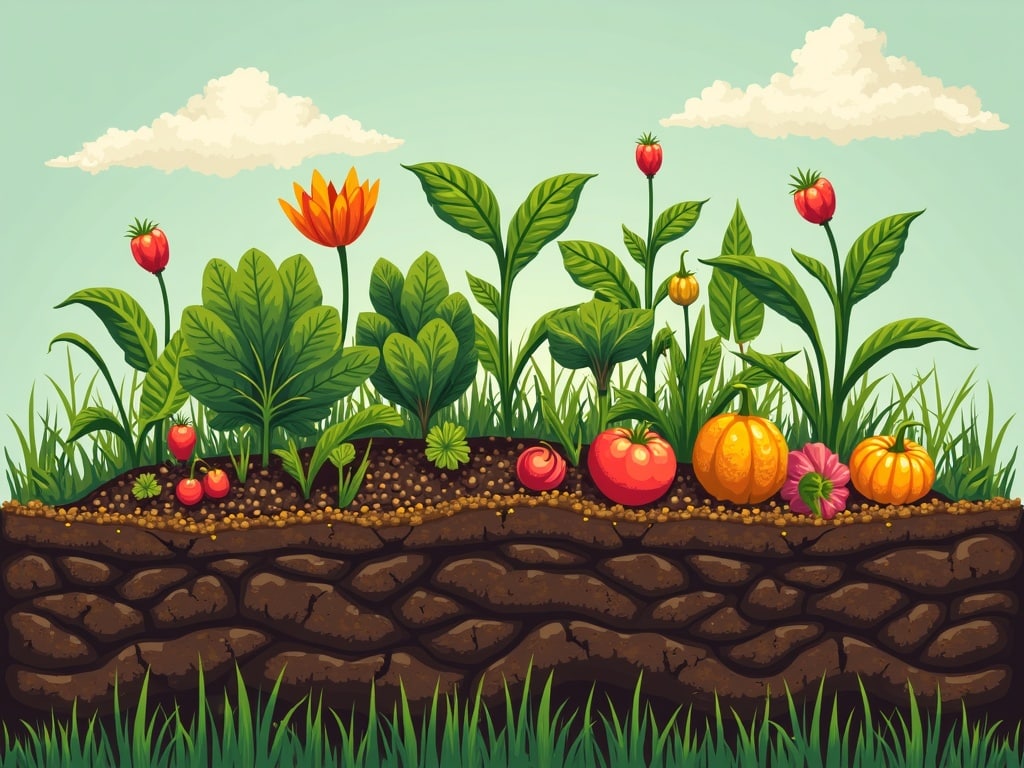Compost Pile vs. Bin: Which Composting Method is Right for You?
The aroma of rich, earthy compost is a gardener’s ambrosia, promising bountiful harvests and vibrant blooms. But before you can conjure this black gold, you need a vessel. You’re faced with a choice: the humble compost pile or the structured compost bin. Both paths lead to fertile ground, but understanding their unique characteristics is key to making the best decision for your needs, space, and lifestyle. Let’s delve into the world of composting to determine whether a free-form pile or a contained bin reigns supreme for your backyard.
Understanding the Basics of Composting
At its core, composting is a natural decomposition process, recycling organic matter into a nutrient-rich soil amendment. Microorganisms, fungi, insects, and worms break down kitchen scraps, yard waste, and other organic materials, transforming them into humus – a dark, crumbly substance teeming with life.
Successful composting hinges on a few key elements:
- Carbon and Nitrogen: Achieving the right balance of browns (carbon-rich materials like dried leaves and shredded paper) and greens (nitrogen-rich materials like grass clippings and vegetable scraps) is crucial for feeding the composting organisms.
- Moisture: The compost pile or bin should be consistently moist, like a wrung-out sponge. Too dry, and decomposition slows down. Too wet, and anaerobic conditions can lead to unpleasant odors.
- Airflow: Oxygen is essential for the aerobic bacteria that drive efficient composting. Turning the pile regularly introduces air and prevents compaction.
- Temperature: As the microorganisms work, they generate heat. A hot compost pile (130-160°F) accelerates decomposition and kills weed seeds and pathogens. Cold composting is also an option, though much slower.
The Compost Pile: Simplicity and Scalability
The compost pile, often the first image that comes to mind when you think of composting, is the most straightforward method. It’s essentially a heap of organic materials left to decompose naturally. Here’s a closer look at its pros and cons:
Advantages of Compost Piles:
- Cost-Effective: Setting up a compost pile requires minimal investment. You can start with just a designated area in your yard.
- Scalable: A compost pile can easily be expanded to accommodate large amounts of yard waste and kitchen scraps, making it ideal for properties with ample space.
- Easy to Start: No complicated assembly or instructions are needed. Simply start layering your materials.
- Good for Bulk Items: Compost piles can handle larger items like branches and whole pumpkins more easily than many enclosed bin systems.
Disadvantages of Compost Piles:
- Aesthetics: Compost piles can be unsightly, especially if not managed properly. They might not be the best option for homeowners concerned with maintaining a pristine yard.
- Pest Attraction: An open compost pile can attract rodents, insects, and other unwanted visitors. Proper management, like burying food scraps, is critical.
- Slower Decomposition: Without regular turning and careful monitoring of moisture and temperature, compost piles tend to decompose slower than well-managed compost bins.
- Odor Potential: Improperly balanced or overly wet compost piles can produce unpleasant odors.
The Compost Bin: Structure and Control
Compost bins offer a more controlled and contained composting environment. They come in various shapes, sizes, and materials, each with its own set of advantages and disadvantages. Common types include tumbler bins, stationary bins made of plastic or wood, and multi-compartment systems.
Advantages of Compost Bins:
- Aesthetics: Compost bins are generally more visually appealing than open piles, helping to keep your yard looking tidy.
- Pest Control: Enclosed bins offer better protection against rodents and other pests.
- Faster Decomposition (Potentially): Tumbler bins, in particular, make turning the compost easier, leading to faster decomposition and higher temperatures.
- Odor Control: When properly managed, enclosed bins can minimize odors.
- Space Efficiency: Compost bins are a good option for smaller yards where space is limited.
Disadvantages of Compost Bins:
- Cost: Compost bins can range in price from relatively inexpensive DIY options to more expensive, commercially manufactured models.
- Limited Capacity: Many compost bins have a limited capacity, which may not be sufficient for large amounts of yard waste.
- Maintenance: While bins offer more control, they also require regular maintenance, including turning and monitoring moisture levels.
- Assembly Required: Some compost bins require assembly, which can be time-consuming.

Choosing the Right Method: Key Considerations
So, which is better – the compost pile or the compost bin? The answer depends on your specific circumstances and preferences. Here are some key factors to consider:
- Space: How much space do you have available in your yard for composting? If space is limited, a compost bin is likely the better option.
- Budget: How much are you willing to spend on a composting system? A simple compost pile is the most budget-friendly option, while a high-end tumbler bin can be a significant investment.
- Aesthetics: How important is it to you that your composting system be visually appealing? If aesthetics are a priority, a compost bin is the clear winner.
- Time and Effort: How much time and effort are you willing to dedicate to composting? A compost pile requires less initial setup but may require more frequent turning and monitoring to ensure optimal decomposition. A tumbler bin can make turning easier, but it also requires regular maintenance.
- Pest Concerns: Are you concerned about attracting pests to your compost? An enclosed compost bin offers better protection against rodents and other unwanted visitors.
- Volume of Waste: How much organic waste do you generate? If you have a large yard and generate a lot of yard waste, a compost pile may be necessary to accommodate the volume.
- Climate: In extremely wet climates, a bin may help maintain the proper moisture levels. In very dry climates, a pile can retain moisture more effectively if properly constructed.
Tips for Successful Composting, Regardless of Method
Regardless of whether you choose a compost pile or a compost bin, following these tips will help you achieve composting success:
- Maintain the Right Balance: Aim for a 2:1 ratio of browns to greens. Add plenty of carbon-rich materials like dried leaves and shredded paper to balance out the nitrogen-rich materials like grass clippings and vegetable scraps.
- Turn Regularly: Turning the compost pile or bin regularly introduces air and speeds up decomposition. Aim to turn it every week or two. Tumbler bins make this job significantly easier.
- Keep it Moist: The compost should be consistently moist, like a wrung-out sponge. Water it as needed, especially during dry periods.
- Chop it Up: Smaller pieces of organic matter decompose faster. Chop up large items like branches and stalks before adding them to the compost.
- Avoid Problematic Materials: Do not compost meat, dairy, oily foods, or pet waste, as these can attract pests and create unpleasant odors.
- Monitor Temperature: Use a compost thermometer to monitor the temperature of your compost pile or bin. A hot compost pile (130-160°F) indicates that decomposition is occurring rapidly.
- Be Patient: Composting takes time. Depending on the method and conditions, it can take anywhere from a few months to a year or more to produce finished compost.
Beyond the Basics: Advanced Composting Techniques
Once you’ve mastered the basics of composting, you can explore more advanced techniques to further enhance your composting efforts:
- Vermicomposting: Using worms to break down organic matter in a worm bin. This is an excellent option for indoor composting and produces nutrient-rich worm castings.
- Bokashi Composting: An anaerobic fermentation process that uses inoculated bran to break down all types of food waste, including meat and dairy.
- Sheet Composting (Lasagna Gardening): Layering organic materials directly onto garden beds to create a fertile growing medium.
Troubleshooting Common Composting Problems
Even with the best intentions, composting can sometimes present challenges. Here are some common problems and how to address them:
- Smelly Compost: This is usually caused by anaerobic conditions due to too much moisture or a lack of airflow. Turn the compost pile regularly and add more brown materials to absorb excess moisture.
- Slow Decomposition: This can be caused by a lack of moisture, a lack of nitrogen, or insufficient airflow. Water the compost pile as needed, add more green materials, and turn it regularly.
- Pests: Prevent pests by burying food scraps deep in the compost pile and using an enclosed compost bin.
The Verdict: Choose What Works for You
There’s no single best composting method. The ideal choice between a compost pile vs. bin depends on your individual needs, preferences, and resources. Consider the factors outlined above to make an informed decision. Whichever method you choose, composting is a rewarding way to reduce waste, improve your soil, and create a healthier environment. Happy composting! Ready to start? Learn more by doing some research on home composting .
